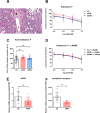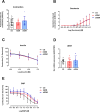Characterization of human placental fetal vessels in gestational diabetes mellitus
- PMID: 39384641
- PMCID: PMC11711144
- DOI: 10.1007/s00424-024-03028-6
Characterization of human placental fetal vessels in gestational diabetes mellitus
Erratum in
-
Correction to: Characterization of human placental fetal vessels in gestational diabetes mellitus.Pflugers Arch. 2025 Jan;477(1):81. doi: 10.1007/s00424-024-03052-6. Pflugers Arch. 2025. PMID: 39661109 Free PMC article. No abstract available.
Abstract
Gestational diabetes mellitus is one of the most common complications during pregnancy. Its prevalence is rapidly increasing worldwide. Gestational diabetes mellitus is leading to an elevated risk for the development of endothelial dysfunction and cardiovascular diseases both in the mother and the child in later life. The underlying pathophysiological mechanisms are not well-understood. Therefore, we aimed to characterize the endothelial function in fetal placental vessels from mothers with gestational diabetes mellitus. In this study, we distinguished between insulin-treated and diet-controlled gestational diabetes mothers and compared them to a normoglycemic control group. The clinical data confirmed pre-conceptional overweight as a risk factor in women with insulin-treated gestational diabetes mellitus. The insulin-treated gestational diabetes group was also characterized by a recent family history of diabetes compared to mothers of the control or diet-controlled gestational diabetes group. Analyses of blood serum from umbilical cords suggested a reduced fetal insulin metabolism in the insulin-treated gestational diabetes group. Vascular function analysis in fetal placental vessels revealed an altered substance P-induced vasorelaxation in vessels from patients with insulin-dependent gestational diabetes. Inhibition of nitric oxide synthase affected only fetal vessel segments from the control group or diet-controlled gestational diabetes group, but not from insulin-dependent gestational diabetes. Finally, we found a significantly decreased substance P receptor (TACR1) mRNA expression in fetal vessel segments from patients with insulin-treated gestational diabetes. In conclusion, we provide evidence that different pathophysiological mechanisms might be responsible for the development of insulin-treated versus diet-controlled gestational diabetes. Only in fetal vessels from patients with insulin-treated gestational diabetes were we able to detect an endothelial dysfunction and a reduced fetal insulin conversion. This provides novel insights into the pathophysiology of the subtypes of gestational diabetes.
Keywords: Endothelial function; Fetal placental vessels; Gestational diabetes; Substance P.
© 2024. The Author(s).
Conflict of interest statement
Declarations. Ethical approval: All procedures performed in studies involving human participants were in accordance with the ethical standards of the institutional ethics committee of the participating center and with the 1964 Helsinki Declaration and its later amendments or comparable ethical standards. All patients received detailed verbal and written information about the study and gave written informed consent. The study was approved by the Ethics Committee of the TUD Dresden University of Technology (EK 277–07-2018 (BO), extension 2022). Competing interests: The authors declare no competing interests.
Figures




References
-
- Sweeting A, Hannah W, Backman H, Catalano P, Feghali M, Herman WH, Hivert MF, Immanuel J, Meek C, Oppermann ML, Nolan CJ, Ram U, Schmidt MI, Simmons D, Chivese T, Benhalima K (2024) Epidemiology and management of gestational diabetes. Lancet 404:175–192. 10.1016/S0140-6736(24)00825-0 - PubMed
-
- Wang H, Li N, Chivese T, Werfalli M, Sun H, Yuen L, Hoegfeldt CA, Elise Powe C, Immanuel J, Karuranga S, Divakar H, Levitt N, Li C, Simmons D, Yang X, IDF Diabetes Atlas Committee Hyperglycaemia in Pregnancy Special Interest Group (2022) IDF diabetes atlas: estimation of global and regional gestational diabetes mellitus prevalence for 2021 by International Association of Diabetes in Pregnancy Study Group’s Criteria. Diabetes Res Clin Pract 183:109050. 10.1016/j.diabres.2021.109050 - PubMed
-
- Armitage JA, Poston L, Taylor PD (2008) Developmental origins of obesity and the metabolic syndrome: the role of maternal obesity. Front Horm Res 36:73–84. 10.1159/000115355 - PubMed
MeSH terms
Substances
Grants and funding
LinkOut - more resources
Full Text Sources
Medical

